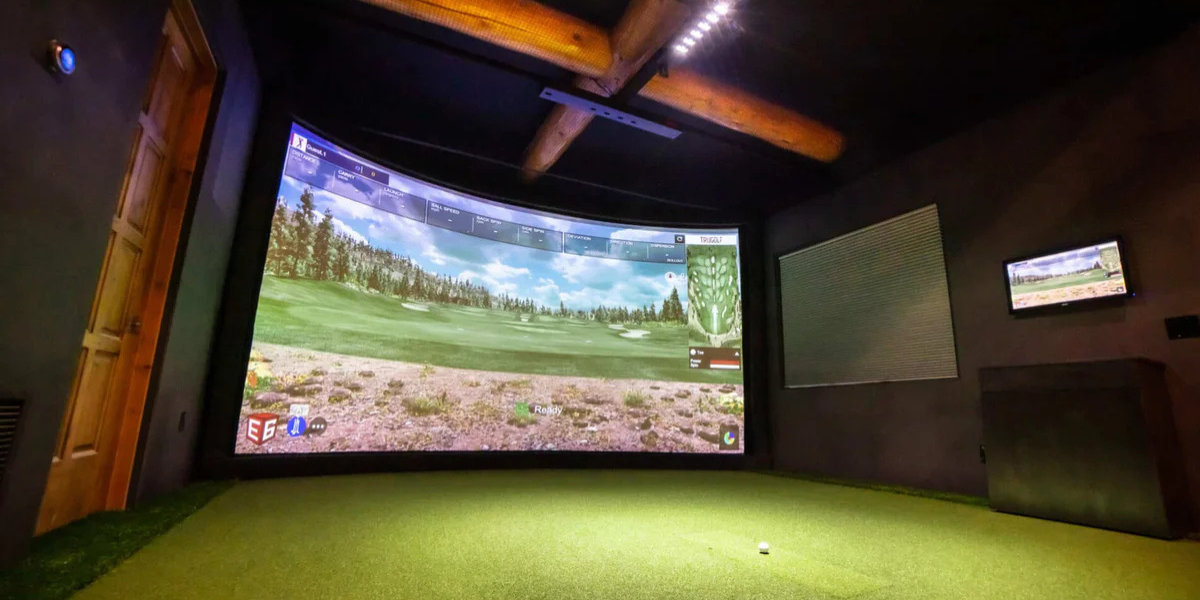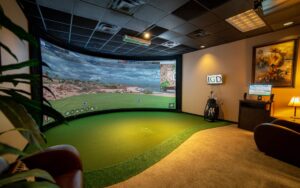Golf simulators are an exciting way to practice and play golf indoors. However, one key factor that many people overlook when setting up their own golf simulation area is the ceiling height. Whether you are building a dedicated golf simulator room or converting part of your garage or basement, understanding the right ceiling height is crucial for a smooth and enjoyable experience.
In this guide, we’ll discuss everything you need How High Ceiling for Golf Simulator Needs to Be, including why it matters, how high it should be, and how to optimize your space for the best results. By the end of this article, you’ll have all the information you need to create a safe, functional, and enjoyable golf simulation environment.
Why Ceiling Height Matters for Golf Simulators
Ceiling height is one of the most important factors when designing a golf simulator room. Here’s why:
- Club Swing Clearance: A golf swing requires a certain amount of space to move freely. A ceiling that’s too low can cause your swing to be restricted, affecting your accuracy and enjoyment.
- Ball Trajectory: When hitting the ball, especially with a driver, the ball will travel high in the air. If the ceiling is too low, the ball may hit the ceiling before it even has a chance to land on the virtual course, ruining the experience.
- Simulator Accuracy: Golf simulators rely on sensors to track the ball’s movement. A low ceiling can interfere with these sensors, leading to inaccurate readings or failure to detect the ball’s trajectory.
Ideal Ceiling Height for Golf Simulators
When setting up a golf simulator, the minimum recommended ceiling height is 9 to 10 feet. However, the optimal height is usually 12 to 14 feet, especially if you plan to use a driver or have taller individuals using the simulator.
Here’s a quick breakdown of what you need to consider:
Minimum Ceiling Height: 9-10 Feet
This height is typically sufficient for short irons and wedges, but drivers and longer clubs might not have enough clearance. This range is the absolute minimum, and any lower than this could restrict the golfer’s swing or cause the ball to hit the ceiling.
Optimal Ceiling Height: 12-14 Feet
This is the most recommended range for full swing shots, including drivers, hybrids, and long irons. A ceiling height of 12-14 feet allows golfers to take full, unrestricted swings, and it helps ensure the ball’s trajectory is accurately captured by the simulator.
For Taller Golfers or High-Speed Swings: 15-20 Feet
If you are taller than average or have a high-speed swing, you might want to consider 15-20 feet of ceiling height. This will provide plenty of clearance for even the most powerful shots and prevent the ball from hitting the ceiling, improving both the experience and accuracy of your simulator.
Factors That Affect Ceiling Height Requirements
While the general guidelines mentioned above will work for most golfers, other factors can impact how high your ceiling needs to be. These include:
1. The Type of Clubs Used
- Short Irons & Wedges: These clubs tend to have a lower ball trajectory and can be used comfortably in rooms with lower ceilings (as low as 9 feet).
- Long Irons & Hybrids: For clubs that require a higher ball flight, you’ll need a minimum of 10-12 feet of ceiling height.
- Drivers: For maximum swing power and a higher trajectory, 12-14 feet of clearance is necessary.
2. Swing Type and Speed
- High-Speed Swings: If you have a more aggressive or faster swing, the ball will travel higher, requiring more space. In this case, a 15-20 foot ceiling is recommended.
- Casual Golfers: For those who play casually and don’t use a full swing, a lower ceiling might be acceptable (9-10 feet).
3. Simulator Technology
The type of golf simulator you use can also impact the ceiling height requirements. Some simulators require more room for tracking, while others may be designed for smaller spaces. Always check the manufacturer’s guidelines for the specific space and ceiling height requirements.
Additional Considerations for Your Golf Simulator Room
Ceiling height isn’t the only factor you should consider when designing your golf simulator room. Here are some additional tips to make your setup even better:
How High Ceiling for Golf Simulator Needs to Be
1. Room Dimensions
While the ceiling height is crucial, the overall size of the room also matters. Aim for at least 10-12 feet of width and 15-20 feet of depth to allow enough space for both the swing and the ball’s path.
2. Flooring
It’s essential to have durable flooring that can handle repeated impacts from golf balls. Many people use rubber mats or carpet with a thick underlay to protect the floor and improve the overall feel of the swing.
3. Lighting
Proper lighting is important for both the golfer’s comfort and simulator accuracy. Make sure the room is well-lit, but avoid direct lighting above the swing area that might cause glare or shadows.
4. Wall and Screen Setup
Ensure you have a sturdy impact screen and protective walls. This setup is especially important for preventing damage to your home and keeping the simulator in good working condition.
How to Maximize Your Space if Ceiling Height is Limited
Not everyone has a room with a high ceiling, but that doesn’t mean you can’t still enjoy your golf simulator. Here are a few solutions for limited ceiling height:
- Use a Smaller Club: If the ceiling is lower than ideal, you may want to use short irons or wedges that require less clearance.
- Opt for a Lower-Profile Simulator: Some simulators are designed for smaller spaces. Look for options that take up less height and are ideal for rooms with limited clearance.
- Adjustable Golf Simulator Setups: Some systems allow you to adjust the height of the impact screen or set up a lower-angle launch to accommodate a smaller room.
Conclusion
The ceiling height for a golf simulator is a key factor that can make or break your experience. A ceiling that’s too low can interfere with your swing, affect the ball’s trajectory, and even cause inaccuracies in the simulator. On the other hand, the right ceiling height allows you to swing freely, hit powerful shots, and enjoy the most realistic experience possible.
For most users, a 12-14 foot ceiling will provide the best results, especially for using drivers and other long clubs. However, if you have a taller room or prefer a more relaxed swing, you can get away with a lower ceiling. Make sure to also consider other factors like room size, flooring, and lighting to create the perfect setup.
If you’re planning to install a golf simulator, take the time to measure your space and select equipment that will allow you to fully enjoy your game. With the right setup, you’ll be practicing your swing and enjoying virtual rounds in no time.


